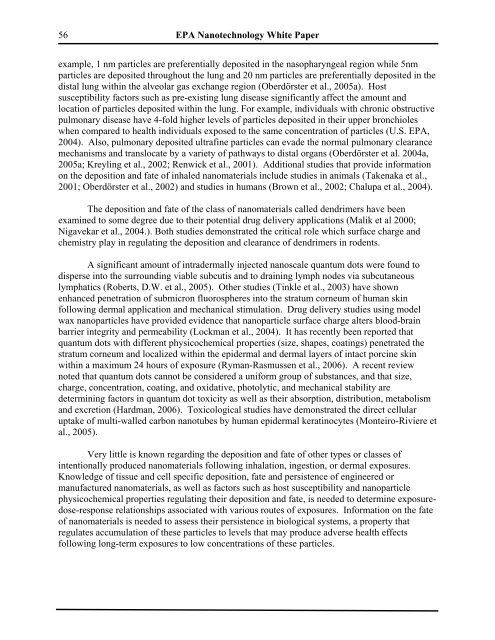Nanotechnology White Paper - US Environmental Protection Agency
Nanotechnology White Paper - US Environmental Protection Agency
Nanotechnology White Paper - US Environmental Protection Agency
Create successful ePaper yourself
Turn your PDF publications into a flip-book with our unique Google optimized e-Paper software.
56 EPA <strong>Nanotechnology</strong> <strong>White</strong> <strong>Paper</strong><br />
example, 1 nm particles are preferentially deposited in the nasopharyngeal region while 5nm<br />
particles are deposited throughout the lung and 20 nm particles are preferentially deposited in the<br />
distal lung within the alveolar gas exchange region (Oberdörster et al., 2005a). Host<br />
susceptibility factors such as pre-existing lung disease significantly affect the amount and<br />
location of particles deposited within the lung. For example, individuals with chronic obstructive<br />
pulmonary disease have 4-fold higher levels of particles deposited in their upper bronchioles<br />
when compared to health individuals exposed to the same concentration of particles (U.S. EPA,<br />
2004). Also, pulmonary deposited ultrafine particles can evade the normal pulmonary clearance<br />
mechanisms and translocate by a variety of pathways to distal organs (Oberdörster et al. 2004a,<br />
2005a; Kreyling et al., 2002; Renwick et al., 2001). Additional studies that provide information<br />
on the deposition and fate of inhaled nanomaterials include studies in animals (Takenaka et al.,<br />
2001; Oberdörster et al., 2002) and studies in humans (Brown et al., 2002; Chalupa et al., 2004).<br />
The deposition and fate of the class of nanomaterials called dendrimers have been<br />
examined to some degree due to their potential drug delivery applications (Malik et al 2000;<br />
Nigavekar et al., 2004.). Both studies demonstrated the critical role which surface charge and<br />
chemistry play in regulating the deposition and clearance of dendrimers in rodents.<br />
A significant amount of intradermally injected nanoscale quantum dots were found to<br />
disperse into the surrounding viable subcutis and to draining lymph nodes via subcutaneous<br />
lymphatics (Roberts, D.W. et al., 2005). Other studies (Tinkle et al., 2003) have shown<br />
enhanced penetration of submicron fluorospheres into the stratum corneum of human skin<br />
following dermal application and mechanical stimulation. Drug delivery studies using model<br />
wax nanoparticles have provided evidence that nanoparticle surface charge alters blood-brain<br />
barrier integrity and permeability (Lockman et al., 2004). It has recently been reported that<br />
quantum dots with different physicochemical properties (size, shapes, coatings) penetrated the<br />
stratum corneum and localized within the epidermal and dermal layers of intact porcine skin<br />
within a maximum 24 hours of exposure (Ryman-Rasmussen et al., 2006). A recent review<br />
noted that quantum dots cannot be considered a uniform group of substances, and that size,<br />
charge, concentration, coating, and oxidative, photolytic, and mechanical stability are<br />
determining factors in quantum dot toxicity as well as their absorption, distribution, metabolism<br />
and excretion (Hardman, 2006). Toxicological studies have demonstrated the direct cellular<br />
uptake of multi-walled carbon nanotubes by human epidermal keratinocytes (Monteiro-Riviere et<br />
al., 2005).<br />
Very little is known regarding the deposition and fate of other types or classes of<br />
intentionally produced nanomaterials following inhalation, ingestion, or dermal exposures.<br />
Knowledge of tissue and cell specific deposition, fate and persistence of engineered or<br />
manufactured nanomaterials, as well as factors such as host susceptibility and nanoparticle<br />
physicochemical properties regulating their deposition and fate, is needed to determine exposuredose-response<br />
relationships associated with various routes of exposures. Information on the fate<br />
of nanomaterials is needed to assess their persistence in biological systems, a property that<br />
regulates accumulation of these particles to levels that may produce adverse health effects<br />
following long-term exposures to low concentrations of these particles.
















